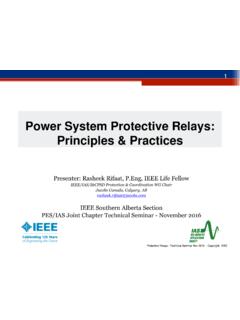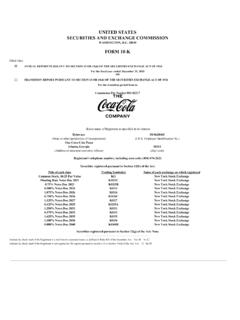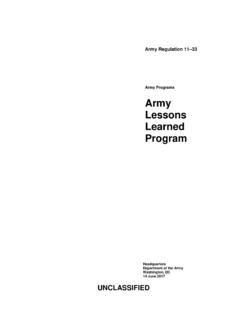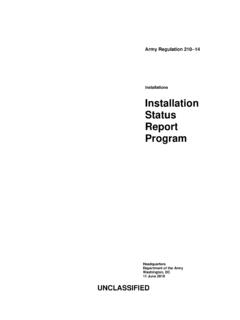Transcription of Hot-Aisle vs. Cold-Aisle Containment
1 Hot-Aisle vs. Cold-Aisle Containment for Data Centers Revision 1 by John Niemann, Kevin Brown, and Victor Avelar Introduction 2 Efficiency benefits of Containment 2 Cold-Aisle containment3 Hot-Aisle containment4 Effect of Containment on the work environment 5 Analysis of CACS and HACS6 Fire suppression considerations 10 Conclusion 11 Resources 12 Appendix 13 Click
2 On a section to jump to it Contents White Paper 135 Both hot-air and cold-air Containment can improve the predictability and efficiency of traditional data center cooling systems. While both approaches minimize the mixing of hot and cold air, there are practical differenc-es in implementation and operation that have signifi-cant consequences on work environment conditions, PUE, and economizer hours. The choice of Hot-Aisle Containment over Cold-Aisle Containment can save 40% in annual cooling system energy cost, corresponding to a 13% reduction in annualized PUE.
3 This paper ex-amines both methodologies and highlights the reasons why Hot-Aisle Containment emerges as the preferred best practice. Executive summary> Hot-Aisle vs. Cold-Aisle Containment for Data Centers APC by Schneider Electric White Paper 135 Rev 1 2 High energy costs and accelerated energy consumption rates have forced data center professionals to consider hot-air and cold-air Containment strategies. According to Bruce Myatt of EYP Mission Critical, the separation of hot and cold air "is one of the most promising energy-efficiency measures available to new and legacy data centers today (Mission Critical, Fall 2007).
4 In addition to energy efficiency, Containment allows uniform IT inlet temperatures and eliminates hot spots typically found in traditional uncontained data centers. While Hot-Aisle Containment is the preferred solution in all new installations and many retrofit installations, it may be difficult or expensive to implement in retrofit applications that have a raised floor, but low headroom or no accessible dropped ceiling plenum. Cold-Aisle contain-ment, although not optimal, may be the best feasible option in these cases.
5 Both Hot-Aisle and Cold-Aisle Containment provide significant energy savings over traditional uncontained configurations. This paper analyzes and quantifies the energy consumption of both Containment methods. While both Hot-Aisle and Cold-Aisle Containment strategies offer energy savings, this paper concludes that Hot-Aisle Containment can provide 40% cooling system energy savings over Cold-Aisle Containment due mainly to increased economizer hours. It also concludes that Hot-Aisle Containment should always be used for new data centers.
6 The Containment of hot or cold aisles in a data center results in the following efficiency benefits. It is important to note that a Hot-Aisle / Cold-Aisle row layout1 is a prerequisite for either type of Containment . Cooling systems can be set to a higher supply temperature (thereby saving ener-gy and increasing cooling capacity) and still supply the load with safe operating temperatures. The temperature of room-oriented uncontained cooling systems is set much lower ( approx 55 F/13 C) than required by IT equipment, in order to prevent hot spots.
7 Hot spots occur when heat is picked up by the cold air as it makes its way from the cooling unit to the front of the racks. Containment allows for increased cold air supply temperatures and the warmest possible return air back to the cooling unit. The benefit of higher return temperature to the cooling unit is better heat exchange across the cooling coil, increased cooling capacity, and overall higher efficiency. This effect holds true for virtually all air conditioning equipment. Some equipment may have limits on the maximum return temperature it can handle, but, in general, all cooling systems yield higher capacities with warmer return air.
8 Elimination of hot spots. Contaiment allows cooling unit supply air to reach the front of IT equipment without mixing with hot air. This means that the temperature of the supply air at the cooling unit is the same as the IT inlet air temperature , uniform IT inlet air temperatures. When no mixing occurs, the supply air temperature can be increased without risk of hot spots while still gaining economizer hours. Economizer hours are increased. When outdoor temperature is lower than indoor temperature, the cooling system compressors don t need to work to reject heat to the outdoors2.
9 Increasing the set point temperature on cooling systems results in a larger number of hours that the cooling system can turn off its compressors and save Humidification / dehumidification costs are reduced. By eliminating mixing between hot and cold air, the cooling system s supply air temperatures can be increased, allow- 1 A rack layout where a row of racks is positioned with the rack fronts facing the rack fronts of the adjacent row. This layout forms alternating hot and cold aisles.
10 2 The difference between outdoor and indoor temperature must be large enough to account for ineffi-ciencies in heat exchangers, imperfect insulation, and other losses. 3 Set points may be constrained in building-wide cooling systems shared by the data center Introduction Efficiency benefits of Containment > What allows more economizer hours? The basic function of a chiller is to remove heat energy from a data center by compressing and ex-panding a refrigerant to keep chilled water at a set supply temperature, typically 45 F/7 C.








